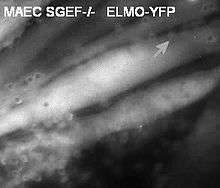Nucleotide exchange factor

Nucleotide exchange factors (NEFs) are proteins that stimulate the exchange (replacement) of nucleoside diphosphates for nucleoside triphosphates bound to other proteins.
Function
Many cellular proteins cleave (hydrolyze) nucleoside triphosphates–adenosine triphosphate (ATP) or guanosine triphosphate (GTP)–to their diphosphate forms (ADP and GDP) as a source of energy and to drive conformational changes. These changes in turn affect the structural, enzymatic, or signalling properties of the protein.[1]
Nucleotide exchange factors actively assist in the exchange of depleted nucleoside diphosphates for fresh nucleoside triphosphates. NEFs are specific for the nucleotides they exchange (ADP or GDP, but not both) and are often specific to a single protein or class of proteins with which they interact.[2]
See also
References
- ↑ Buday, L; Downward J (1993). "Epidermal growth factor regulates p21ras through the formation of a complex of receptor, Grb2 adapter protein, and Sos nucleotide exchange factor". Cell. 73 (3): 611–620. doi:10.1016/0092-8674(93)90146-H. PMID 8490966. Retrieved 10 August 2012.
- ↑ de Rooij, Johan; Fried J. T. Zwartkruis; Mark H. G. Verheijen; Robbert H. Cool; Sebastian M. B. Nijman; Alfred Wittinghofer; Johannes L. Bos (3 December 1998). "Epac is a Rap1 guanine- nucleotide-exchange factor directly activated by cyclic AMP" (PDF). Nature. 396 (6710): 474–477. doi:10.1038/24884. PMID 9853756. Retrieved 10 August 2012.